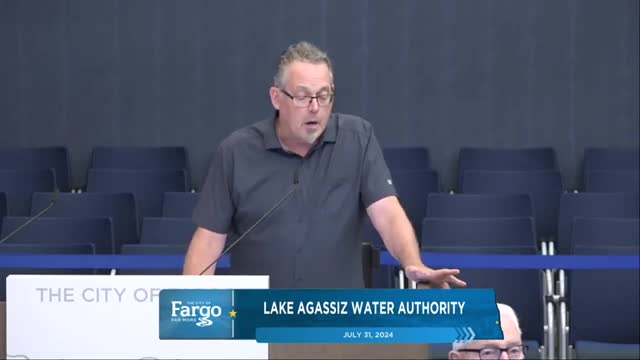Water Crisis Sparks Urgent Solutions in North Dakota
August 01, 2024 | Fargo , Cass County, North Dakota

This article was created by AI summarizing key points discussed. AI makes mistakes, so for full details and context, please refer to the video of the full meeting. Please report any errors so we can fix them. Report an error »

In a recent government meeting, officials discussed significant challenges and developments regarding water supply systems in North Dakota. A key concern raised was the stark reduction in water nominations, with one area only receiving approval for 20% of its anticipated capacity. This reduction is alarming, particularly as it affects regions like Central Plains and Carrington, which are crucial for delivering high-quality water.
The meeting highlighted the need for a strategic approach to address these challenges. Some systems have requested delays in signing up for water allocations to better organize their commissions and explore cooperative strategies. This reflects a growing urgency among stakeholders to ensure sustainable water management.
A detailed analysis of regional water nominations revealed that the Jamestown Valley area, along with Fargo, Cass, and Grand Forks, has made the largest requests. In contrast, areas like Wahpeton have struggled with water shortages, particularly after the construction of the Cargill facility, which has limited their capacity to support new industries.
Plans are underway to enhance water infrastructure, including the construction of a new intake at Lisbon and a pump station to facilitate water delivery to Wahpeton and surrounding areas. The meeting underscored the importance of collaboration among local leaders, particularly those involved in the Southeast Water System, to navigate the complexities of water distribution.
Officials are also developing financial models to assist water users in understanding the costs associated with pipeline systems. These models aim to provide clarity on operational expenses and potential revenue from industrial water sales, helping communities assess the viability of their water supply strategies.
Overall, the discussions emphasized the critical need for effective water management solutions in North Dakota, as stakeholders work to balance demand with sustainable practices in the face of ongoing challenges.
The meeting highlighted the need for a strategic approach to address these challenges. Some systems have requested delays in signing up for water allocations to better organize their commissions and explore cooperative strategies. This reflects a growing urgency among stakeholders to ensure sustainable water management.
A detailed analysis of regional water nominations revealed that the Jamestown Valley area, along with Fargo, Cass, and Grand Forks, has made the largest requests. In contrast, areas like Wahpeton have struggled with water shortages, particularly after the construction of the Cargill facility, which has limited their capacity to support new industries.
Plans are underway to enhance water infrastructure, including the construction of a new intake at Lisbon and a pump station to facilitate water delivery to Wahpeton and surrounding areas. The meeting underscored the importance of collaboration among local leaders, particularly those involved in the Southeast Water System, to navigate the complexities of water distribution.
Officials are also developing financial models to assist water users in understanding the costs associated with pipeline systems. These models aim to provide clarity on operational expenses and potential revenue from industrial water sales, helping communities assess the viability of their water supply strategies.
Overall, the discussions emphasized the critical need for effective water management solutions in North Dakota, as stakeholders work to balance demand with sustainable practices in the face of ongoing challenges.
View full meeting
This article is based on a recent meeting—watch the full video and explore the complete transcript for deeper insights into the discussion.
View full meeting
